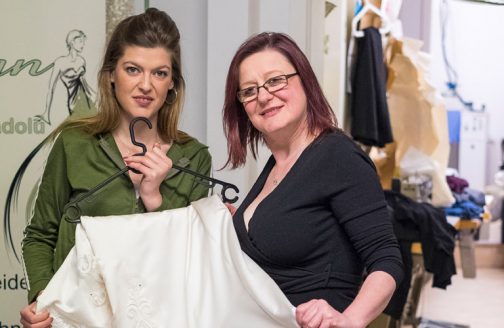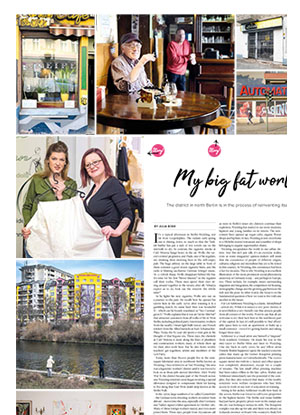Berlin Wedding: A district in the process of reinventing itself

It’s a typical afternoon in Berlin-Wedding, not far from Leopoldplatz. The radiant early-spring sun is shining down, so much so that the Turkish barber has put a rack of wet towels out on the sidewalk to dry. In contrast, the cigarette smoke at Cafe Morena hangs heavy in the air. Wolle, the tavern’s retired proprietor, and Paule, one of his regulars, are drinking their morning beer in the still-empty pub. The huge ashtray on the large table in front of them contains a good dozen cigarette butts, and the radio is blasting saccharine German Schlager music. At 12 o’clock sharp, Wolle disappears behind the bar. It’s time for his first “blood thinner,” as the regulars call their vodka. These men spend their days sitting around together in the tavern, after all, “whadyaexpect us to do, look out the window the whole time?”
As he lights his next cigarette, Wolle sets out on a journey to the past. He recalls how he opened his tavern here in the early 1970s, after winning it in a gambling match. Its name back then was Sexmuffel II – which can be loosely translated as “Sex Curmudgeon II.” Wolle explains that it was an “erotic film bar” that attracted customers from all walks of life in West Berlin, including political party functionaries, workers from the nearby Osram light bulb factory and French soldiers from the Allied barracks at Kurt-Schumacher-Platz. Today, the 82-year-old sports a wide grin at the thought of that bygone era. These days, the clientele at Cafe Morena is more along the lines of plumbers and construction workers, many of whom show up for their after-work beer. But he also hosts weekly teachers’ get-togethers, artists and members of the Left Party.
Today, more than 86,000 people live in the nine-square-kilometer area in northwest Berlin known as Wedding. Once referred to as “red Wedding,” the area was a legendary workers’ district until it was forced to look on as those jobs moved elsewhere. After World War II, the district became part of the French sector, and Wedding residents soon began receiving a special allowance designed to compensate them for having to live along that East-West death strip known as the Berlin Wall.
In the 1970s, large numbers of so-called Gastarbeiter – the German term denoting workers recruited from abroad – moved into the area, especially after Germany and Turkey signed a labor agreement in October 1961. Many of these foreign workers stayed, and even more joined them. These days, people from 165 nations call Wedding their home. In fact, one out of every two residents here has a “migration background.”
In the 1980s, a number of big Wedding-based factories, such as AEG, Osram and Rotaprint, closed their doors, most likely because West Berlin’s status as an isolated island within East Germany had rendered it unprofitable as a location for industry. Many workers lost their jobs, which meant that all the shops along the large boulevards of Müllerstrase and Badstrase also lost their customers.
The district never quite recovered from that setback. To this day, in some areas you’ll still find casinos lining the streets alongside junk shops. Both the unemployment rate and the crime rate are high. And yet, Wedding has started to change. In the past several years, as rents in Berlin’s inner-city districts continue their explosion, Wedding has started to see more students, hipsters and young families on its streets. The newcomers have opened up vegan cafes, organic flower shops and hip bars. In fact, Wedding is now even home to a Michelin-starred restaurant and a number of shops belonging to organic supermarket chains.
Wedding encapsulates the world in one urban district. And this isn’t just talk, it’s an everyday reality, even as some misguided opinion-makers still insist that the coexistence of people of different origins, cultures, religions and mentalities has yet to be tested in this country. In Wedding, this coexistence has been a fact for decades. This is why Wedding is an excellent illustration of the most prominent social phenomena underway in Germany today – and perhaps in Europe, too. These include, for example, issues surrounding migration and integration, the competition for housing, demographic change and the growing gap between the rich and the poor. In other words, the focus is on the fundamental question of how we want to live with one another in the future.
For Les Schliesser, Wedding is a classic Ankunftsstadt – arrival city. While it is indeed a very poor district, it is nevertheless a very friendly one that attracts people from all corners of the world. Word is out that all are welcome to try their luck here in the northwest part of the capital. In fact, it’s still possible to find affordable space here to rent an apartment or build up a small existence – even if it’s getting harder and taking longer these days.
Schliesser is a visual artist and himself a “migrant” from southern Germany. He made his way in the mid-1990s to Berlin-Mitte and later to Wedding. One day back in early 2000, he and fellow artist Daniela Brahm happened upon the stacked concrete cubes that made up the former Rotaprint printing press manufacturer on Gottschedstrase. The 10,000 square-meter site with its 11 factory and office spaces was completely abandoned, except for a couple of tenants. The last small offset printing machine had been taken offline in the late 1980s. Brahm and Schliesser immediately saw the potential of the complex. But they also noticed that many of the nearby residents were welfare recipients who had little access to work or any sort of education or training.
Sitting in his atelier, Schliesser recalls how back in the 2000s, Berlin was forced to sell 6,000 properties to the highest bidder. The Berlin real estate bubble had just burst, property prices were in the dumps and the city was looking to reduce its debt. The Rotaprint complex was also up for sale, and there was already an Icelandic investor on board who wanted to build loft apartments there. What ensued was a true real-estate poker match. The most effective card Schliesser and Brahm had up their sleeves – along with their 11 fellow shareholders in their newly founded gGmbH company – was their idea for a never-before-seen mixed-use concept for the site alongside a sophisticated financing model. In 2007, with the help of an instrument known as the Erbbaurecht (heritable building right), which gave the gGmbH a 100-year lease, they were able, together with two foundations, to acquire the former printing press site for €600,000, thus rendering the re-sale of the complex prohibited. The transaction was based on the mutually binding premise of “no profit by ownership.” ExRotaprint was born.
Looking back, Schliesser is convinced that their success can be a role model for how to approach Berlin’s urban development in a manner that doesn’t revolve around profit. In his words, their approach is “proof that renters can refurbish and develop a complex by themselves by means of self-management.” Today, he co-manages ExRotaprint’s business operations with Brahm. The complex is at 100-percent capacity and several of the site’s buildings – all of which are now historically protected monuments – have been refurbished with the help of two architects, a building loan and income from rent.
The co-managers rent out the space based on a strict allocation philosophy: one-third of tenants are tradespeople, including carpenters and the like; the second third are organizations that perform social work, such as a German school for migrants; and the final third of the space is rented out to artists and creatives, including ateliers and 17 rehearsal rooms for musicians.
“The district desperately needs jobs, educational opportunities and social support,” says Schliesser. By making specific choices when it comes to renting out their space, he explains, they can decide who sets up shop on their site and how Wedding can profit from their work. These days, their vision of a non-profit real estate company – the ExRotaprint team refers to itself as a “social sculpture” – has become more important than ever. Even in Wedding, money is now starting to play an increasingly large role, as Schliesser is well aware. In some places, rents have increased fourfold within a year, and the gentrifying tendency of pushing out people with less money has long since been underway.
In the small dressmaking shop for women’s and children’s clothing Cosa on the ground floor of a residential building on Tegeler Strase, Nuray Anadolu and her 24-year-old daughter Ipek Yeşildağ are very busy these days. April is a very popular month for Muslim weddings. Ramadan is in May this year, which means no one marries in that month. Hoş geldiniz! Welcome to Turkish Wedding! Or maybe it would be more accurate to say “Welcome to German-Turkish Wedding!” Indeed, just like in the districts of Kreuzberg and Neukölln, the Anatolians are among those Berliners who have lived in Wedding the longest.
Anadolu moved to Wedding in 1992, and her daughter Ipek was born in the district. A professional fashion tailor from western Turkey, Anadolu sports a very fashionable bob, her hair is dyed purple and she has a tattoo on her lower arm. Wedding is her home. It’s where she can speak Turkish to people from her home country on every corner; it’s where she can celebrate Muslim holidays with members of her community; and it’s also where she can find mosques right in her neighborhood. And even though she spends most of her time in her sewing shop, she’s quick to note that these surroundings give her tremendous strength.
And yet, living alongside her compatriots presents
certain challenges and complications. As the 48-year- old Anadolu points out, many of the older people, especially those from eastern Turkey, are highly conservative. “They stay among themselves, only visit Turkish doctors, go to Turkish supermarkets and even keep a distance from other Muslims,” she says. And by “other Muslims,” she means women such as Nuray Anadolu and Ipek Yeşildağ, that is, women who don’t wear headscarves yet still pray to Allah for several minutes every night before going to bed.
Religion and politics are themes that both women try to keep out of their fashion business. After all, there are so many other things to talk about. “Tradition or not, Turkish weddings are total bling bling,” says Ipek, whose name translates as “silk.” For most of the brides who come to the mother-daughter duo, the women create baroque “Sisi-type” dresses with lots of tulle, rhinestones and lace, as well as matching dresses for the bridesmaids. Up to 10 women – mothers, sisters and aunts – have been known to come into their workspace to discuss every detail of the bride’s dress. Anadolu recalls that her own wedding, which took place in Turkey in the early 1990s, was also a largescale affair; however, it was an event the then 21-year-old didn’t have much of a say in.
She has since divorced her husband. Indeed, her life path – which took her from the position of textile workshop manager at a Berlin-based company to her current status as a businesswoman who says what she thinks and makes her own decisions – did not jibe with her ex-husband’s image of women. “After 17 years of marriage, it was a difficult decision to divorce,” says Anadolu, sighing, yet with a look of satisfaction. Her daughter Ipek will soon be completing her BA in fashion management and hopes to join her mother’s business at some point. For Nuray Anadolu and Ipek Yeşildağ, the district of Wedding is the perfect place to pursue a good life based on traditional values and a self-determined future.
Wolle, the 82-year-old pub owner, also foresees a dazzling future for Wedding. He even goes as far as to predict “a cultural revolution.” There are more and more well-educated people moving to the district, he says. For his own part, he’d like to stay “until they have to carry me out.” That makes sense, seeing as Wolle was born in his grandfather’s Schultheiss pub just a few blocks away.
Julia Boek
is co-publisher of Berlin-Wedding – The Photobook.




